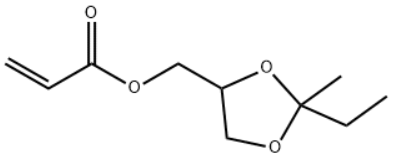MEDOL-10 CAS#: 69701-99-1; ChemWhat Code: 1491556
Identification
| Product Name | MEDOL-10 |
| IUPAC Name | (2-ethyl-2-methyl-1,3-dioxolan-4-yl)methyl prop-2-enoate |
| Molecular Structure |  |
| CAS Registry Number | 69701-99-1 |
| EINECS Number | No data available |
| MDL Number | MFCD32669888 |
| Beilstein Registry Number | No data available |
| Synonyms | propenoic acid (2-ethyl-2-methyl-1,3-dioxolan-4-yl)methyl esterpropenoic acid (2-methyl-2-ethyl-1,3-dioxolan-4-yl)methyl esteracrylic acid (2-methyl-2-ethyl-1,3-dioxolan-4-yl)methyl esteracrylic acid 2-methyl-2-ethyl-1,3-dioxolanylmethyl ester(2-ethyl-2-methyl-1,3-dioxolane-4-yl)methyl acrylate(2-methyl-2-ethyl-1,3-dioxolane-4-yl)methyl acrylate(2-ethyl-2-methyl-1,3-dioxolan-4-yl)methyl acrylate |
| Molecular Formula | C10H16O4 |
| Molecular Weight | 200.234 |
| InChI | InChI=1S/C10H16O4/c1-4-9(11)12-6-8-7-13-10(3,5-2)14-8/h4,8H,1,5-7H2,2-3H3 |
| InChI Key | VWAQEEYHYXPMHK-UHFFFAOYSA-N |
| Canonical SMILES | C=CC(=O)OCC1COC(C)(CC)O1 |
| Patent Information |
| No data available |
Physical Data
| Appearance | Colorless transparent liquid |
| Solubility | No data available |
| Flash Point | No data available |
| Refractive index | No data available |
| Sensitivity | No data available |
Spectra
| No data available |
Route of Synthesis (ROS)

| No data available |
Safety and Hazards
| Pictogram(s) |   |
| Signal | Warning |
| GHS Hazard Statements | H315 (100%): Causes skin irritation [Warning Skin corrosion/irritation] H317 (100%): May cause an allergic skin reaction [Warning Sensitization, Skin] H319 (50%): Causes serious eye irritation [Warning Serious eye damage/eye irritation] H332 (50%): Harmful if inhaled [Warning Acute toxicity, inhalation] H335 (50%): May cause respiratory irritation [Warning Specific target organ toxicity, single exposure; Respiratory tract irritation] H411 (50%): Toxic to aquatic life with long lasting effects [Hazardous to the aquatic environment, long-term hazard] Information may vary between notifications depending on impurities, additives, and other factors. |
| Precautionary Statement Codes | P261, P264, P264+P265, P271, P272, P273, P280, P302+P352, P304+P340, P305+P351+P338, P317, P319, P321, P332+P317, P333+P317, P337+P317, P362+P364, P391, P403+P233, P405, and P501 (The corresponding statement to each P-code can be found at the GHS Classification page.) |
Other Data
| Transportation | NONH for all modes of transport |
| Under the room temperature and away from light | |
| HS Code | No data available |
| Storage | Under the room temperature and away from light |
| Shelf Life | 1 year |
| Market Price | USD |
| Druglikeness | |
| Lipinski rules component | |
| Molecular Weight | 200.235 |
| logP | 1.352 |
| HBA | 4 |
| HBD | 0 |
| Matching Lipinski Rules | 4 |
| Veber rules component | |
| Polar Surface Area (PSA) | 44.76 |
| Rotatable Bond (RotB) | 5 |
| Matching Veber Rules | 2 |
| Use Pattern |
| 1.UV inkjet diluent, UV bonding, EB curable coatings, inks, and adhesives 2.Improves hardness, chemical resistance, and scratch resistance 3.High-performance resins 4.Used as a comonomer for engineering polymers requiring durability and stability 5.Electronics and optical materials 6.Contributes to low shrinkage, dimensional stability, and resistance to aggressive solvents 7.Adhesives and sealants 8.Provides improved cohesive strength and thermal resistance |
Buy Reagent | |
| No reagent supplier? | Send quick inquiry to ChemWhat |
| Want to be listed here as a reagent supplier? (Paid service) | Click here to contact ChemWhat |
Approved Manufacturers | |
| Warshel Chemical Ltd | http://www.warshel.com/ |
| Want to be listed as an approved manufacturer (Requires approvement)? | Please download and fill out this form and send back to approved-manufacturers@chemwhat.com |
Other Suppliers | |
| Watson International Limited | Visit Watson Official Website |
Contact Us for Other Help | |
| Contact us for other information or services | Click here to contact ChemWhat |

